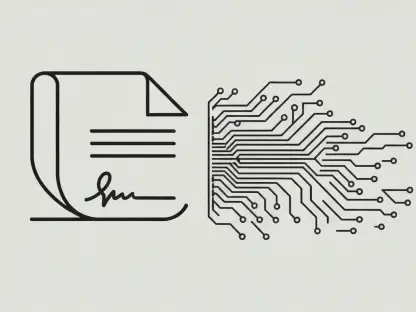Debates about the role of artificial intelligence in the insurance industry are intensifying, as both experts and observers closely monitor developments. With rapidly evolving technologies and varying perspectives, the question remains whether AI truly is the future of insurance or just another technological whim. This article examines the transformational impacts of AI, contrasting corporate strategies, and the structural challenges the sector faces to illuminate whether AI marks the beginning of a new era for insurance or is merely a transient phenomenon.
Reflections on the Past and Present
Missteps in Understanding AI
In 2018, State Farm launched an ad campaign that mocked AI-powered insurance chatbots, portraying them as incapable of providing the empathetic customer service that human agents could. This portrayal captured a common misconception prevalent at the time— that AI technology lacked the capacity for nuanced human interaction. The campaign suggested that AI’s reliance on algorithms severely restricted its ability to connect with customers on an emotional level, thereby undermining its effectiveness in the insurance industry. This misunderstanding hindered the appreciation of AI’s potential benefits and demonstrated resistance to technological change.
Such misconceptions failed to recognize the rapid advances in AI, particularly in natural language processing and machine learning, which enable these systems to evolve continually. The depiction of AI as emotionless and robotic reflected a significant underestimation of AI’s capabilities to not only improve efficiency but also contribute empathetically. State Farm’s misjudgment implied a resistance to the potential benefits AI could unlock, marking an early indication of the divide between traditional and technology-forward approaches in the insurance sector. Viewing AI through a narrow and outdated lens, the advertisement overlooked the transformative potential AI-driven solutions hold, a stance which would later be critically reassessed.
Contrasting Approaches
Lemonade CEO Dan Schreiber offered a counterpoint during his keynote speech at Insurtech Insights Europe, emphasizing that Lemonade’s AI-powered bots had proven to be more efficient and empathetic than human agents. This stance highlighted the stark contrast between traditional insurers’ resistance to AI and progressive companies’ embrace of these technologies. According to Schreiber, Lemonade’s AI systems not only streamlined processes but also enhanced the customer experience, establishing AI as a central pillar in the company’s operations. By showcasing superior performance in both accuracy and customer satisfaction, Lemonade aimed to challenge the lingering skepticism surrounding AI.
Schreiber highlighted several instances where AI’s advantages were evident, including quicker claim resolutions and the ability to operate round-the-clock, something human agents could not match. This positions AI as a pivotal component in their service model, designed to meet 21st-century consumer expectations. Lemonade’s strategic use of AI underlined the inadequacies in traditional approaches and served as a practical demonstration of how integrating advanced technology can lead to superior customer outcomes. By leveraging AI, Lemonade effectively showcased how embracing technology could provide a competitive edge, unlike the cautious and often dismissive stance of traditional insurance firms.
Structural Challenges and Innovations
Legacy Systems and Resistance
Despite the clear advantages AI can offer, many traditional insurance companies remain encumbered by legacy systems that stymie adoption of new technology. These outdated systems are often complex, inefficient, and resource-intensive, acting as “black holes” that consume valuable time and capital. The antiquated infrastructure makes it exceedingly difficult to integrate AI solutions seamlessly, thereby slowing down digital transformation efforts. Additionally, entrenched management cultures frequently exhibit resistance to change, valuing conventional methods over innovative approaches. This resistance is often rooted in concerns about job displacement and the perceived risks associated with transitioning from well-known systems to new technologies.
The persistence of these legacy systems means that many insurers are unable to capitalize on the efficiencies and customer experience improvements offered by AI. The inability to quickly adapt and implement AI also leaves these companies at risk of falling behind more technologically adept competitors. The industry is witnessing a divide where companies entrenched in conventional methods struggle with adapting AI, while progressive firms like Lemonade move swiftly forward. Overcoming these hurdles is not merely a technical challenge but also a cultural one, requiring a shift in mindset from risk-averse to innovation-driven within the organizational hierarchy.
Overcoming Obstacles
Addressing these structural challenges demands a dual approach: revamping outdated systems and cultivating a forward-thinking management culture that is receptive to innovation. Investments in modernizing IT infrastructures are critical for creating an environment conducive to AI integration. Insurance companies must phase out legacy systems in favor of modular, scalable, and AI-friendly architectures that allow for quicker deployment of technological solutions. This transition requires not only financial investments but also substantial planning and strategic execution. Encouragingly, insurers that commit to these transformations can expect enhancements in operational efficiencies and customer satisfaction.
Equally important is fostering a culture of innovation within the organization. This involves training and re-skilling existing employees to work alongside AI systems and championing a top-down approach where leadership models the value of embracing new technologies. By promoting an innovation-friendly culture, companies can mitigate resistance and create an atmosphere where technological advancements are seen as opportunities for growth rather than threats. The success stories of tech-forward companies like Lemonade provide valuable case studies, illustrating the potential rewards that come from overcoming these obstacles. Embracing AI-driven transformation can redefine traditional insurance practices, offering a more efficient, responsive, and customer-centric approach.
The Present and Future Role of AI
Current Applications
Currently, AI is far from a futuristic concept and has become an integral part of operations for pioneering companies within the insurance sector. For instance, Lemonade has integrated AI into various facets of its operations, from policy administration to claims processing. AI-powered bots handle customer inquiries and process claims almost instantaneously, providing a level of service that far exceeds traditional methods. These systems can analyze vast datasets to detect fraud, assess risks with greater precision, and even provide personalized recommendations to customers, thus enhancing both efficiency and satisfaction.
AI technologies also excel in predictive analytics, enabling insurers to foresee potential risks and adjust policies accordingly. This capability allows companies to pre-empt emerging trends, mitigate risks more effectively, and provide tailored solutions to their customers. These applications demonstrate that AI is not just an auxiliary tool but a core component transforming insurance operations into more streamlined and proactive systems. As these technologies continue to evolve, their integration into everyday operations underscores the pragmatic shift from theoretical to practical, reflecting how AI’s potential is being actualized in real-time.
Future Potential
Looking to the future, AI’s role in the insurance industry is set to expand beyond current applications, ushering in new efficiencies and capabilities. One area poised for growth is real-time data analysis, which can offer insurers unprecedented insights into customer behaviors and market trends. This development will allow for more refined risk assessments and timely adjustments in policy pricing and structure, revolutionizing how insurers approach customer engagement and service delivery. AI-driven automation in underwriting processes is another frontier that promises greater accuracy and efficiency, thereby reducing errors and expediting service.
In addition to operational enhancements, AI could also play a significant role in developing predictive models for emerging risks such as cyber threats and climate change. These models will help insurers not only respond swiftly to crises but also take preemptive action to mitigate potential losses. As these technologies become more sophisticated, the nature of roles within the industry will also change, with more emphasis on human-AI collaboration. The transformative potential of AI extends far beyond automated tasks, promising a comprehensive overhaul of how risk is managed, policies are developed, and services are delivered. The advancement of AI signifies a dynamic shift toward more anticipatory and adaptable insurance industry practices.
Financial Successes and Market Impact
Lemonade’s Performance
Lemonade’s innovative approach to leveraging AI has translated into remarkable financial successes and a significant market impact. By focusing on efficiency and customer satisfaction through AI-driven processes, Lemonade has streamlined its operations, reducing both the time and cost associated with policy issuance and claim processing. This technological edge has drawn substantial venture capital investments, underscoring market confidence in AI’s potential to revolutionize insurance. Lemonade’s successful initial public offering further validated its business model, attracting broad investor interest and capitalizing on the growing appetite for technologically-advanced service providers.
Financially, Lemonade has reported improved loss ratios and positive adjusted free cash flow, providing tangible evidence of AI’s efficacy in driving profitability and operational performance. The company’s data-centric approach allowed for precise risk underwriting and swift fraud detection, further enhancing financial stability and offering compelling proof of AI’s value proposition. These metrics reflect a paradigm shift, illustrating how AI’s integration can lead to superior financial outcomes in the competitive insurance landscape. Lemonade’s performance adds weight to the argument that AI, when effectively harnessed, can transform industry norms and set new benchmarks for efficiency and profitability.
Industry Implications
The broader implications of Lemonade’s success suggest significant lessons for the entire insurance industry. First, it calls into question the sustainability of business models that resist technological integration, signaling an urgent need for traditional insurers to reassess their strategies. The successes achieved by AI-driven firms like Lemonade underscore the pressing need for industry-wide adaptation to maintain competitiveness and meet evolving customer demands. Companies that fail to recognize and respond to these advancements risk becoming obsolete in a market increasingly dominated by tech-savvy players.
Moreover, the industry must embrace a proactive approach to regulatory compliance and ethical considerations surrounding AI use. The integration of AI into insurance practices raises important questions about data privacy, algorithmic bias, and the ethical implications of automation. Addressing these concerns responsibly can help to build trust and ensure that technological advancements benefit all stakeholders. The market dynamics indicate that AI is not a passing trend but a crucial element shaping the future of insurance. Therefore, companies must navigate these changes thoughtfully, leveraging AI’s transformative potential while adhering to regulatory standards and ethical principles.
Bridging the Divide
Traditional Versus Progressive
The insurance industry stands at a critical juncture, with a palpable divide between traditional companies and those embracing AI-driven innovation. This division is marked by differences in operational efficiencies, customer satisfaction, and overall market competitiveness. Traditional insurers, reliant on outdated systems and conventional practices, find themselves increasingly challenged to keep pace with technologically adept companies that leverage AI to optimize processes and deliver superior services. The consequence of maintaining outdated practices is evident in the widening performance gap, where tech-forward innovators are redefining industry standards, and traditional firms risk deceleration.
The contrast between these approaches is stark, underlining an urgent need for traditional insurers to re-evaluate their strategies. Failing to adapt could result in diminished market share and irrelevance in a rapidly evolving industry landscape. Progressive companies showcase the tangible benefits of AI integration, offering a blueprint for how the insurance industry can evolve to meet modern demands. The necessity for traditional insurers to bridge this divide is evident, requiring not only technological upgrades but also a shift in mindset towards embracing innovation actively.
The Critical Need for Adaptation
Debates are heating up about the role of artificial intelligence in the insurance industry, with experts and observers keeping a close eye on developments. As technologies evolve rapidly and opinions differ, the central question is whether AI genuinely represents the future of insurance or is just another fleeting trend. This discussion explores how AI is transforming the industry, looking at different corporate strategies and the structural challenges that come along.
The insurance sector is experiencing significant changes due to AI’s implementation in various processes. Some believe this marks a pivotal shift towards more efficient and customer-centric services. On the other hand, skeptics argue that AI may encounter regulatory hurdles and ethical issues, potentially limiting its impact.
By evaluating the positive advancements and potential obstacles, this article aims to shed light on whether artificial intelligence is set to revolutionize insurance or will pass as a transient technological curiosity.









